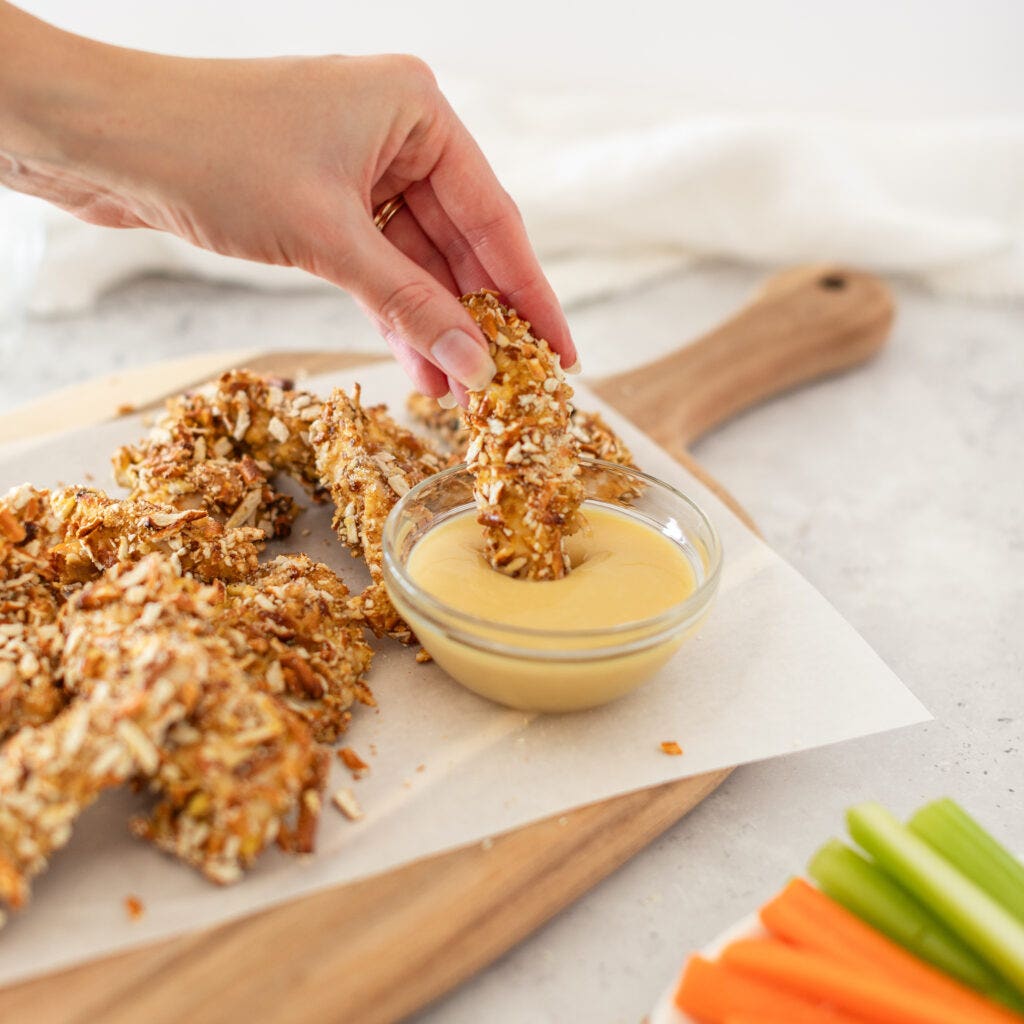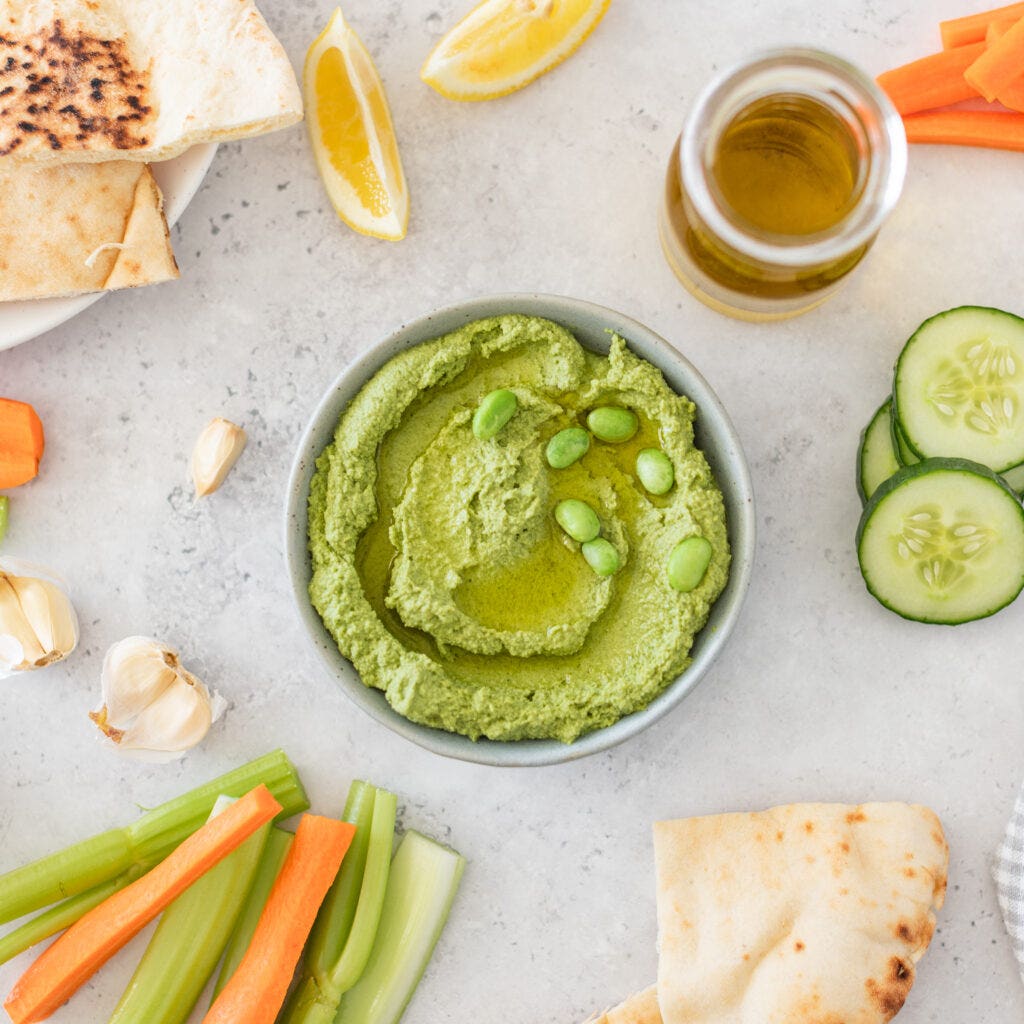Have you ever wondered how much protein you actually need? Protein is such a hot topic, and something I commonly get asked about as a dietitian.
Protein plays a HUGE role in our diet, and is one of the three main macronutrients, along with carbohydrates and fat, that we need to survive and function. Protein is used in our body to make things like cells, muscles, tissues, bones, hair, hormones and more. It is part of every single cell in our body… so yeah, it’s important!
In this article we’ll dig into the science to talk about what protein is, the best sources of protein, how much of it we really need, when we should eat it, and how much is too much?!
What is Protein?
Protein is made up of amino acids, which are the building blocks of protein: imagine a bunch of beads (amino acids) on a string (protein). Amino acids are broken into two categories: essential and non-essential amino acids (1). Simply put, essential amino acids cannot be made by our body so we need to get them from foods we eat whereas non-essential amino acids can be made or synthesized by our body.

What is the Difference Between Animal and Plant Protein?
While protein is found in almost all foods (even veggies), not all foods are created equal. Protein sources can be categorized as complete or incomplete. Technically speaking, a complete protein has all the essential amino acids our body needs. Incomplete proteins do not contain all the essential amino acids. In general, animal-based foods are considered complete with the exception of some plant-based foods like soy and quinoa. Plant-based sources like beans, lentils, and grains are typically considered incomplete because they are lacking one or more of the essential amino acids, but that doesn’t mean they are any less beneficial, we just have to be a little more strategic!
Essential amino acids are still found in plant-based foods, but we need to pair them with complementary plant-based sources (2) of protein to be sure we are meeting all of our protein needs. While you can absolutely get enough protein (3) through a vegan or vegetarian diet, it is important to be aware of the complementary proteins in your diet and pair them accordingly. You don’t need to eat these complementary proteins at the same time; as long as they are consumed throughout your day, you’re fine.
Complete Protein Pairings
Any of following food combinations form complete protein pairings Food 1 + Food 2 = complete protein
| Food 1 | Food 2 |
| Peanut Butter | Whole Wheat Toast |
| Beans | Rice |
| Hummus | Pita Bread |
| Refried Beans | Tortillas |
| Lentils | Barley |
| Bean Soup | Crackers |
| Peas | Pasta |
| Lentils | Almonds |
*Note: these foods do not need to be eaten together at the same time, but the food pairs provide the essential amino acids needed by your body.


What are the Best Sources of Protein?
Protein can be found in many foods, but our bodies digest and absorb some proteins a little better than others. This is known as bioavailability. Generally speaking, animal proteins contain high amounts of protein and are said to be more bioavailable; however, that doesn’t mean you can only achieve your protein needs with animal-based foods. Saturated fat should also be a consideration for health reasons: limit red meat and choose fish more often.
Plant-based proteins offer many benefits (4) too and should absolutely be part of a healthy and well-balanced diet that meets all your protein requirements. At the end of the day, there is no right or wrong answer. Both plant-based and animal-based diets can provide high quality proteins that will fuel your body with the nutrition it needs to function.
If you follow a vegan or vegetarian diet, you can rest assured that you will successfully be able to achieve all of your protein requirements (5) through plant-based protein sources. In fact, we could all benefit from incorporating more plant-based protein sources within our diet! Plant-based foods offer the added benefit of additional fiber, vitamins and minerals that can be very beneficial for our overall health. Whether you choose to include animal or plant-based proteins in your diet the most important key is to ensure you are including a source of protein at each meal.
How Much Protein do you Really Need?
The question we have all been waiting for: how much protein do you really need? There is little concensus on the topic, and the answer is…it depends! The Recommended Dietary Allowance (RDA) (6) for protein in Canada is 0.8 g/kg of body weight, however it is important to note that this is the recommended minimum amount to prevent a deficiency and is not necessarily the ideal for all individuals, especially those with a higher physical activity level (7) or older adults. Many experts (including myself) suggest higher protein recommendations (8) of 1.2-2.2 g/kg of body weight, with the higher range reserved for athletes, body builders, or those healing from an illness or injury.
Can You Eat Too Much Protein?
How much protein is “too much” is a relative concept. A bit of extra protein isn’t a problem for most people: excess protein will get stored in the body for energy. Of course, as with anything, excessive intake may lead to health issues (possible impact to kidney function, weight gain etc.).
If you are focusing on a balanced approach that includes a wide variety of foods from all food groups and consider your individual needs, it is unlikely you will be consuming too much. If you are feeling confused about how much protein you need, it is recommended to work with a dietitian to help determine your needs.
When is the Best Time to Eat Protein?
Ideally, you want to spread your protein intake throughout the day, ensuring that you consume a significant source of protein with every meal for optimal muscle protein synthesis (9), or muscle growth. If you enjoy numbers a good rule of thumb is about 25-30g (10) of protein per meal.
At the end of the day, the exact amount of protein you need truly depends on your lifestyle, health and fitness goals, activity level, and digestion. If in doubt, consult a dietitian!
Can Eating More Protein Help with Weight Loss?
The short answer is yes, it may. Including a significant amount of protein in each meal (aim for 25-30 grams per meal) helps keep you full for longer and supplies your body with much-needed nutrients to build and maintain muscle mass. Of course, that isn’t the full picture. Balancing the rest of your diet, managing stress, and incorporating daily movement are also key.
Examples of Protein Sources:
| Food Source | Serving Size | Grams of Protein/Serving |
| Chicken | 125mL (1/2 cup) | 21 |
| Beef | 125mL (1/2 cup) | 21 |
| Eggs | 2 eggs | 12 |
| Salmon | 125mL (1/2 cup) | 21 |
| Milk (Cow’s) | 250mL (1 cup) | 9 |
| Cheese | 50g (1 ½ oz) | 12 |
| Greek Yogurt | 175mL (3/4 cup) | 14 |
| Lentils | 175mL (3/4 cup) | 12 |
| Quinoa | 125mL (1/2 cup) | 4 |
| Chickpeas | 175mL (3/4 cup) | 12 |
| Black Beans | 175mL (3/4 cup) | 12 |
| Walnuts | 60mL (1/4 cup) | 5 |
| Almonds | 60mL (1/4 cup) | 8 |
| Cashews | 60mL (1/4 cup) | 5 |
| Peanut Butter | 30mL (2 Tbsp) | 8 |
| Pumpkin Seeds | 60mL (1/4 cup) | 17 |
| Sunflower Seeds | 60mL (1/4 cup) | 6 |
| Hummus | 175mL (1/4 cup) | 8 |
| Tofu | 175mL (3/4 cup) | 12 |
| Tempeh | 125mL (1/2 cup) | 15 |
| Soy Milk | 250mL (1 cup) | 7 |
| Hemp Seeds | 60mL (1/4 cup) | 13 |
The Bottom Line
There are so many pieces to the puzzle when it comes to our individual protein needs and other factors including our age, sex, activity level, goals and overall health status play a role in determining our needs. While the current Canadian recommendation for protein is 0.8 g/kg of body weight, there is good evidence to argue that 1.2-2.2g/kg of body weight better meets many people’s needs. Don’t obsess over counting the specific grams of protein you’re eating (life is too short), but be sure to include a significant source of protein at each meal along with a balance of other foods to nourish your body.
Curious about how you can squeeze more protein into your diet? Have a look at some of these protein-packed recipes from our meal plan, Fraîche Table! Sign up for a free 10-day trial to get delicious, healthy recipes on your table week after week. Here are just a few of the high protein recipes waiting for you inside the meal plan!
– Peanut Butter Chocolate Yogurt Cups



Disclaimer: This blog is for general information purposes only and is not intended to serve as medical advice or recommendation. If you are curious about your protein needs it is important to seek individual advice and support from a registered medical or health care professional and it is always recommended to consult with a healthcare professional before making any significant changes. ***
References:
- Lopez, Michael J. and Shamim S. Mohiuddin. “Biochemistry, Essential Amino Acids.” StatPearls, StatPearls Publishing, 13 March 2023.
- Hoffman, Jay R, and Michael J Falvo. “Protein – Which is Best?.” Journal of sports science & medicine vol. 3,3 118-30. 1 Sep. 2004
- Melina, Vesanto et al. “Position of the Academy of Nutrition and Dietetics: Vegetarian Diets.” Journal of the Academy of Nutrition and Dietetics vol. 116,12 (2016): 1970-1980. doi:10.1016/j.jand.2016.09.025
- Hertzler, Steven R et al. “Plant Proteins: Assessing Their Nutritional Quality and Effects on Health and Physical Function.” Nutrients vol. 12,12 3704. 30 Nov. 2020, doi:10.3390/nu12123704
- Craig, Winston J et al. “Position of the American Dietetic Association: vegetarian diets.” Journal of the American Dietetic Association vol. 109,7 (2009): 1266-82. doi:10.1016/j.jada.2009.05.027
- Canada, Health. “Government of Canada.” Canada.Ca, / Gouvernement du Canada, 18 Dec. 2023, www.canada.ca/en/health-canada/services/food-nutrition/healthy-eating/dietary-reference-intakes/tables/reference-values-macronutrients.html.
- Aragon, A.A., Schoenfeld, B.J., Wildman, R. et al. International society of sports nutrition position stand: diets and body composition. J Int Soc Sports Nutr 14, 16 (2017). https://doi.org/10.1186/s12970-017-0174-y
- Phillips, Stuart M et al. “Protein “requirements” beyond the RDA: implications for optimizing health.” Applied physiology, nutrition, and metabolism = Physiologie appliquee, nutrition et metabolisme vol. 41,5 (2016): 565-72. doi:10.1139/apnm-2015-0550
- Symons, T Brock et al. “A moderate serving of high-quality protein maximally stimulates skeletal muscle protein synthesis in young and elderly subjects.” Journal of the American Dietetic Association vol. 109,9 (2009): 1582-6. doi:10.1016/j.jada.2009.06.369
- Lonnie, Marta et al. “Protein for Life: Review of Optimal Protein Intake, Sustainable Dietary Sources and the Effect on Appetite in Ageing Adults.” Nutrients vol. 10,3 360. 16 Mar. 2018, doi:10.3390/nu10030360

